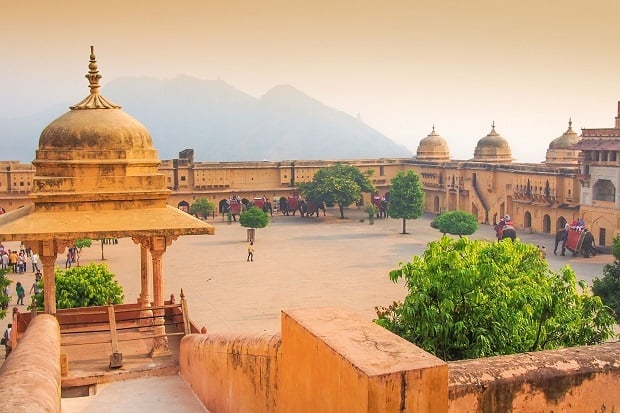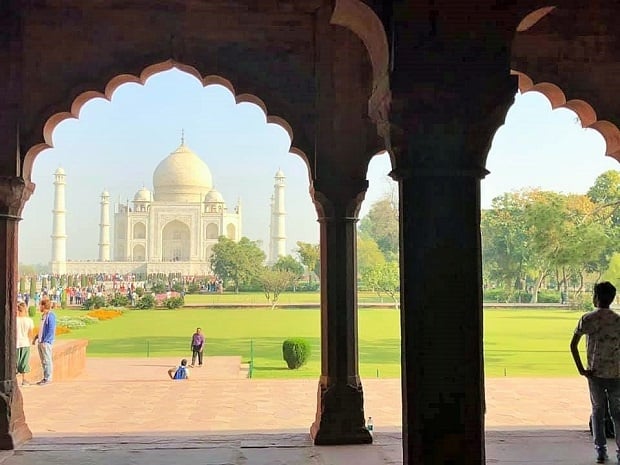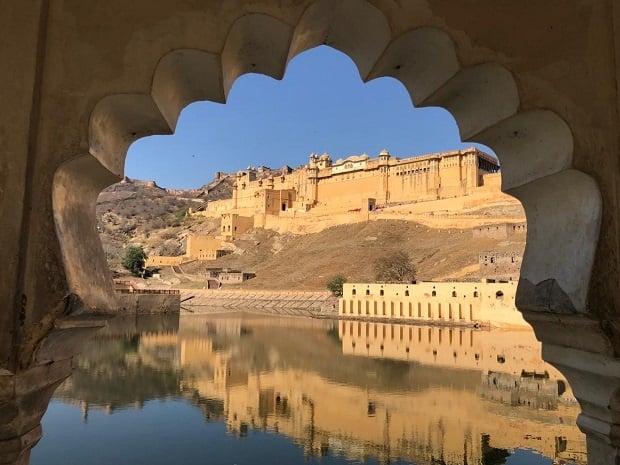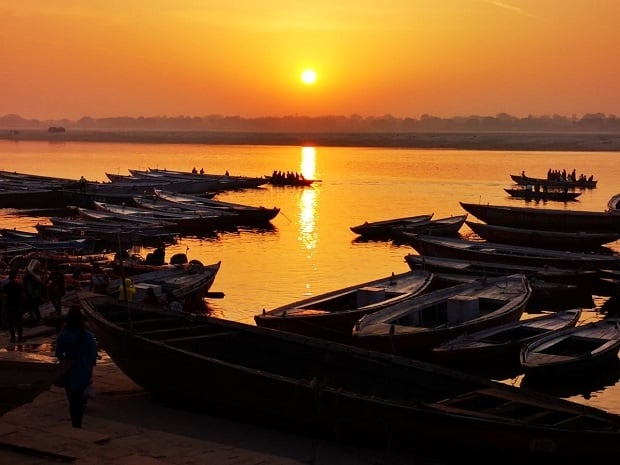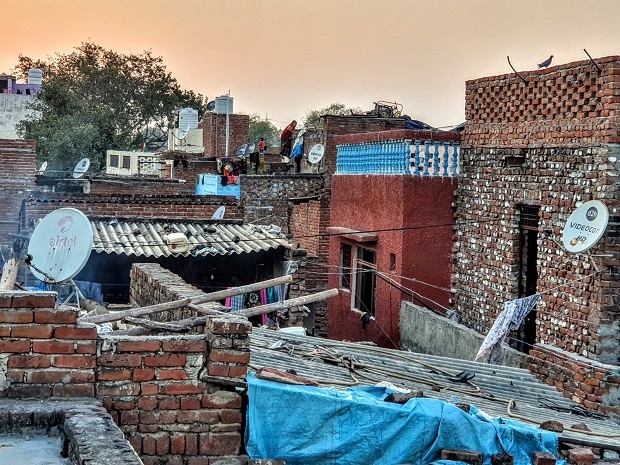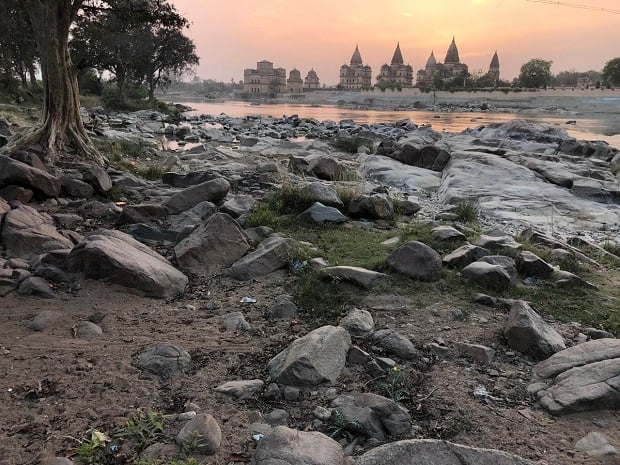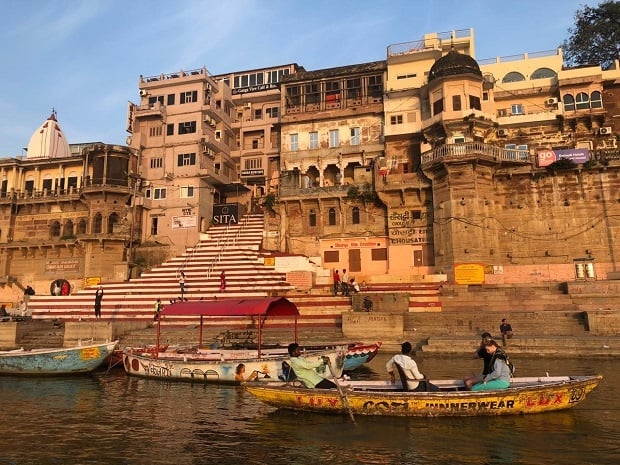Colourful Northern India
- Celebrate the Festival of Colours (Holi) with a local family
- Discover Delhi, both old and new
- Taj Mahal and the Mughal Heritage Walk
- Inter-active cooking experience
- The Pink City of Jaipur
- The carved temples of Khajuraho
- Varanasi and the Ganges River
Overview
Delhi, Jaipur, Agra, Khajuraho and Varanasi...
Join us as we discover colourful India! On this 16-day tour we discover the rich heritage of this extraordinary country as we visit the Golden Triangle – Delhi, Jaipur and Agra. We visit remarkable monuments, ancient forts and the Taj Mahal, a magnificent and unequalled tribute to love.
We balance the chaos of iconic cities with the splendour of nature as we visit Keoladeo Ghana, a UNESCO World Heritage Site and rated as one of the finest bird reserves in the world.
During our time in India, we will enjoy an interactive cooking experience and join a local family for the day, as they celebrate Holi, the incredible Festival of Colours.
We end our tour in Varanasi, one of the oldest cities on earth, and witness sunset and sunrise over the holy River Ganges.
Join Live the Journey in February 2026 and discover Colourful Northern India!
Itinerary
DAY 0: JOHANNESBURG / CAPE TOWN - DELHI
Meet at the check-in counter for your international flight from Johannesburg or Cape Town to Delhi, India.
DAY 01: DELHI ARRIVAL
Namaste! Welcome to New Delhi, the capital city of India and the start of your adventure! Our friendly team will be waiting outside the arrivals hall to transfer you to your hotel. Note that standard check-in time at the hotel is from 14h00.
Lunch is included at the hotel.
Enjoy a welcome dinner.
About Delhi
Delhi is a huge city and one of the oldest on the planet. It is estimated to be over 5000 years old and rebuilt a staggering 11 times. Officially two separate cities, the old city of Delhi and New Delhi are really two parts of one sprawling metropolis with several attractions. Old Delhi with its predominantly Muslim population and Mughal architecture is comprised mostly of a labyrinth of tiny lanes crowded with rickshaws and lined with run-down 17th-century havelis. Offering a real contrast to the congestion of the old city, New Delhi has been the capital of the Republic of India since Independence and is home to many historic monuments as well as impressive Raj-era architecture. Largely planned and built by the British, the central administrative area of the city was laid out as a testament to Britain's imperial pretensions. At its very heart is the magnificent Rashtrapati Bhawan (then known as Viceroy's House).
O/N The Metropolitan including lunch and dinner.
DAY 02: NEW DELHI
Our full day guided sightseeing tour today introduces you to the modern simplicity of New Delhi. It is the capital of India and is situated in the north-central part of the country on the western bank of the Yamuna River, adjacent to and just south of Old Delhi. Our tour today covers Qutab Minar, Ghandi House Museum, Humayun’s Tomb and India Gate.
We enjoy a late lunch and later return to the hotel.
Dinner is at leisure tonight.
O/N The Metropolitan or similar including breakfast and lunch.
DAY 03: OLD DELHI
Today we explore Old Delhi. This vibrant city is full of forts, monuments, temples, mosques and more. During the 16th and 17th centuries, Delhi was an important centre of the Mughal dynasty, and the British made it the capital city in 1911. We take in Raj Ghat, Jama Masjid, the Spice Market and the Sikh Temple.
Located in the heart of the old city is Asia’s largest spice market, called Khari Baoli. In the narrow alley of the spice market, you will find thousands of shops dealing in local and exotic herbs and spices. Learn about the various spices, therapeutic values and their culinary use. This is one of the most vibrant and colourful markets in Delhi and is a photographer’s paradise.
Following an exciting morning, enjoy a light lunch.
After an eventful day, we return to the hotel where we will enjoy dinner.
O/N The Metropolitan or similar including breakfast, lunch and dinner.
DAY 05: FESTIVAL OF COLOURS, JAIPUR
This morning, we travel through the streets of the Pink City to witness the locals celebrating the Holi Festival or the Festival of Colours, as it is also known. Our destination is the Hotel Narain Niwas - a noble’s house in the erstwhile state of Jaipur – where we will join in the celebrations with live music, dance, drinks and mouthwatering delicacies. It is an immersive experience and to celebrate the festival, guest will be provided with a white Kurta pajama (Indian dress), Rajasthani Turban, a Pichkaris (water gun) and herbal colourings which are used to “colour” the white Indian dress in the company of the host, his friends and family. Enjoy the many interesting traditions and customs of the festival that have its own regional variances. *
Holi Festival (Festival of Colours): Holi is a spring festival also known as the Festival of Colours and Love. It is an ancient Hindu religious festival and is primarily observed in India, Nepal, and other regions of the world with significant populations of majority Hindus or people of Indian origin. Holi celebrations start with a Holika bonfire on the night before Holi where people gather, sing and dance. The next morning is a carnival of colours, where everyone splashes each other with dry powder and coloured water. Groups carry drums and musical instruments, go from place to place, sing and dance. The festival signifies the victory of good over evil, the arrival of spring and the end of winter.
After a festive morning, we visit a family jeweller this afternoon as well as the Anokhi Museum of Hand Printing, located in a magnificently restored haveli or mansion. The museum displays a varied selection of block printed textiles alongside images, tools and related objects. Like crafts worldwide, the block printing industry faces serious challenges trying to keep pace with modern manufacturing. The Anokhi Museum of Hand Printing addresses this fragile situation primarily through education.
*Please note that guests that do not wish to participate in any of the festival activities, may choose to spend the time at leisure.
O/N Hotel Ramada or similar including breakfast, lunch and festive Holi dinner.
DAY 04: DELHI – JAIPUR
This morning, we drive to Jaipur, affectionately known as the Pink City as Maharaja Ram Singh had all the Old City painted a welcoming pink in 1876 to herald a visit by the Prince of Wales (later King Edward VII), it is also the bustling capital of the state of Rajasthan.
We enjoy a tour of the City Palace and Jantar Mantar – an old yet cleverly designed space observatory.
About Jaipur
The vibrant capital of Rajasthan is a flamboyant showcase of Rajasthani architecture and a firm favourite on tourist itineraries as the third corner of India’s Golden Triangle alongside Delhi and Agra. Popularly known as the ‘Pink City’, in 1876 Maharaja Ram Singh had the whole city painted pink, traditionally a colour associated with hospitality, to welcome the Prince of Wales (later Edward VII). Jaipur was chosen by Maharaja Jai Singh II (1693-1743) for his capital. A skilled astronomer and visionary, he worked with superb Bengali architect Vidyadhar Bhattacharya to complete design and construction of Jaipur in less than eight years and the 18th century UNESCO-listed Jantar Mantar is the largest and best preserved of five observatories built by the astronomer prince. The observatory complex is fascinating with giant stone structures that Jai Singh II had built to measure time, chart the declination of celestial bodies and predict eclipses. Other must-sees within the city include the City Palace Complex. The palace is a blend of Rajasthani and Mughal architecture. The son of the last Maharaja and his family still reside in a wing of the palace. Also of interest is the Palace of the Winds, known as Hawa Mahal, whose facade is adorned with elaborate, perforated screens. The Old City, the actual Pink City, is a great place to wander around with ancient walls encircling bustling bazaars selling beautiful textiles and jewellery. For many visitors a highlight is the magnificent Amber Fort, a striking vision in yellow and pink sandstone with a royal palace and numerous courtyards.
O/N Hotel Ramada or similar including breakfast, lunch and dinner.
DAY 07: JAIPUR – BHARATPUR
Morning drive towards Bharatpur. On arrival, we visit the ancient stepwell at Chand Baori, dating back to the 9th century. Following our visit to the stepwell we enjoy lunch at our hotel, before checking in.
About Bharatpur
The walled town of Bharatpur, in Rajasthan, is just a stone’s throw from the border with the state of Uttar Pradesh. Boasting the massive Lohagarh Fort (built in 1732) plus traditional markets and mosques, it’s a good place to relax, explore and soak up the town's rich cultural heritage. However, the real reason travellers come to Bharatpur is to visit Keoladeo Ghana National Park. The park can be toured on foot or by bicycle rickshaw and during a visit you may be fortunate enough to spot majestic cranes, spoonbills, pink flamingos, white ibises and grey pelicans as well as the birds of prey including vultures, harriers, peregrine falcons and ospreys. A UNESCO World Heritage Site, Keoladeo Ghana is rated as one of the finest bird reserves in the world.
Afternoon visit to Keoladeo Ghana National Park, a UNESCO World Heritage Site, where we’ll enjoy a leisurely bicycle rickshaw ride through the park while birdwatching.
O/N Laxmi Vilas Palace or similar including breakfast, lunch and dinner.
DAY 06: JAIPUR
Enjoy breakfast before departing for another wonderful day of sightseeing in Jaipur.
We start with a morning photo stop at Palace of the Wind.
Then, we visit the magnificent pink, fort-palace of Amber - a wonderful example of Rajput architecture just north of Jaipur. *
*While you might see other visitors to the Amber Fort arrive by elephant, Live the Journey has made a decision not to use this form of transport and our guests will be transferred by jeep or similar up to the fort or may take a leisurely walk.
Another highlight of our day is a visit to a noble family for an interactive cooking experience.
O/N Hotel Ramada or similar including breakfast, lunch and dinner.
DAY 08: BHARATPUR – AGRA
Today we make our way to Agra, visiting Fatehpur Sikri en route. This was the former imperial capital of the great Mughal emperor Akbar. Built between 1569 and 1585, it has been deserted for more than four centuries, abandoned in 1600 due to a meagre supply of water.
About Agra
Home to one of the most iconic monuments in the world, Agra is India's shining star and a universal favourite with travellers from around the world. Constantly under attack from the fierce Indian heat, this dusty city has obtained international reverence thanks to it being the site of the famous Taj Mahal, a mausoleum constructed in phases between 1632 and 1643, with extra work continuing on until 1653. It was commissioned by the Mughal Emperor in honour of his favourite wife Mumtaz, whose tomb still lies within its walls. There are few things on the planet as breath-taking as getting an up-close view of this historical masterpiece. Although the Taj Mahal has stolen the limelight of Agra and will realistically be at the forefront of Agra's tourism market for the foreseeable feature, this city also houses two other UNESCO World Heritage sites, making it one of the few cities in the world that can boast three of these accolades. The Agra Fort comes under this category and for obvious reason. Built with red stone and covered, inside and out, with intricate carvings and decoration, this structure is truly a sight to behold. The final UNESCO World Heritage site in Agra, which is situated within India's famous Golden Triangle route, is Fatehpur Sikri, a city that was built by the Emperor Akbar to be the capital of the Mughal Empire. It contains stunning palaces as well as the Jama Masjid, which is one of the largest mosques in India.
Late afternoon we enjoy a golf cart ride to the legendary Taj Mahal, the most extravagant monument ever built for love. Here you will receive a guided explanation, then free time to enjoy the romantic sunset.
This evening you are in for a treat as we enjoy a musical show about the story of the Taj Mahal.
O/N Grand Mercure or similar including breakfast, lunch and dinner.
DAY 09: AGRA
This morning you will be taken across the Yamuna River for the Mughal Heritage Walk. This walk gives you a rare behind-the-scenes glimpse into the culture and lifestyle of the people living next to this world-famous tourist attraction in the village of Kachpura.
The walk covers a stretch of 1 km and is a community-based tourism enterprise. The walk will be facilitated by a youth from the local community who has been trained as a tour facilitator to provide both historical facts and anecdotes. You will walk to Gyarah Sidi, which is carved out of a single stone and enabled the early Mughals to study the star constellations, visit the Kachhpura village which overlooks the Taj Mahal, and the Humayun Mosque. The children of Kachhpura will organise a street play for you and the girls are happy to show you how skilled they are in making Henna tattoos, an ancient Indian Body Art. It is used in creating intricate ethnic or contemporary designs and exotic patterns on various parts of the body, though traditionally applied to the hands and feet of women, preparing for special ceremonies. Once thought only for women, men are finding it a nice alternative to permanent tattoos. But now both men and women enjoy the "temporary tattoo".
This afternoon we proceed to visit Agra Fort. Agra Fort is a historical fort and was the main residence of the emperors of the Mughal Dynasty until 1638.
O/N Grand Mercure or similar including breakfast, lunch and dinner.
DAY 11: ORCHHA
Enjoy breakfast at the hotel this morning followed by a visit to the Orchha Fort.
You have the afternoon at leisure to explore Orchha, or to simply relax. (Lunch not included today.)
Late afternoon, return to the river to visit the cenotaphs.
O/N Hotel Amar Mahal or similar including breakfast and dinner.
DAY 10: AGRA – ORCHHA
This morning after breakfast, we travel by express train to Jhansi and drive onward to Orchha. Situated on the banks of the River Betwa, Orchha is set amongst a wonderful complex of well-preserved 16th century temples and palaces, that you will explore this afternoon.
About Orchha
Filled with ancient buildings, casting long and imposing shadows across the land, Orchha is a historical village that has maintained a strong cultural identity and is representative of what the Mughal Empire once was. The town was founded in 1531 by Rudra Pratap Singh and it sits on the banks of the Betwa River, which splits in to 7 channels in this precise location. With its faded grandeur and sleepy atmosphere, Orchha is a beautiful destination for anyone who wants a change of scenery, some time to relax and to travel back in time to when legend and mystery pervaded every corner of life. One of the most prominent structures in Orchha is the eponymous Orchha Fort. It houses numerous temples and palaces including the impressive Raj Mahal and Rai Parveen Mahal. While some of the buildings within show notable signs of wear and tear, the exquisiteness of them is just as overpowering as it must have been when they were first constructed. The Jhansi Fort is slightly smaller yet equally worth visiting, if only for the fascinating museum located in its interior.
Today the afternoon is at leisure. Late afternoon the group get together for the walk to the river for the sunset pictures over the cenotaphs.
O/N Hotel Amar Mahal or similar including breakfast, lunch and dinner.
DAY 12: ORCHHA – KHAJURAHO
Travelling south-east, we arrive in Khajuraho, home of the resplendent Hindu temples which were built during the Chandela dynasty over a 100-year burst of creative genius from 950-1050 AD. Famed above all for their delicate sensuality, how and why they were built still remains a mystery. The incredible skill of the artisans is evident throughout.
About Khajuraho
Located in the northern state of Madhya Pradesh, Khajuraho is famous for its unique Hindu and Jain temples that rate a close second behind the Taj Mahal as India's top attraction. Khajuraho’s temples were largely built during a major creative burst of genius from 950AD to 1050AD during the Chandela period, a dynasty that survived for five centuries before falling to the mighty Mughal onslaught. Their sheer beauty and immense size have confounded experts as to why they were built in Khajuraho, a small town then and still a relatively small town now. Indeed, the Chandelas appear to have forgotten about the temples soon after they were completed, and it took ‘rediscovery’ by the British before these awesome masterpieces were fully appreciated in India. Immortalised in stone, the carved temples display exceedingly artistic aspects of Indian life a millennium ago but are famed above all for their erotic nature. Surprisingly, the erotic sculptures only account for a tenth of the temples' artistic murals with the majority dedicated to mythical stories and scenes of everyday life. The incredible skill of the Chandela artisans is evident throughout, with friezes as little as 10 cm wide crammed to the gunnels with detailed jewellery and hairstyles of the subject matter. Constructed from high quality sandstone, the temples change colour throughout the day with the waxing and waning light, from warm pinks at sunrise to glowing yellows at sunset.
O/N Hotel Ramada or similar including breakfast, lunch and dinner.
DAY 14: VARANASI
This morning, we enjoy a sunrise boat ride on the holy Ganges where we’ll view the ancient religious tradition of ritual cleansing that takes place on the many riverbank ghats (riverside steps). Later, we embark on a tour of the city.
We visit the silk loom late morning.
This evening, we return to the river witness an aarti ceremony on the river Ganges as the sun sets.
O/N Rivatas by Ideal or similar including breakfast, lunch and dinner.
DAY 13: KHAJURAHO - VARANASI
Enjoy an early breakfast before departure by road to Varanasi with a packed lunch.
Perhaps the holiest city in India, Varanasi, also known as the city of Shiva, is one of the oldest cities on earth, situated on the banks of the holy River Ganges.
Arrive late afternoon in Varanasi after a long day on the road.
About Varanasi
Located on the banks of the River Ganges and considered to be one of India's most holy of cities, Varanasi is an overwhelming melting pot of colour, chaos and spirituality. Believed to have been founded by Shiva as early as the 11th century, Varanasi - or Kashi and Benares as it has variously been known - is also one of the world's oldest continuously inhabited cities, serving as an important centre of learning and civilization for over 2,000 years. Today thousands of Hindu pilgrims from all over the country come to Varanasi to bathe in the waters of the sacred River Ganges to wash away their sins. The Hindu rituals of life and death take place very publicly on the city’s famous riverside ‘ghats’, the name given to steps that lead down to holy waters. Here cremations on funeral pyres take place throughout the day with ceremonies held out in the open and the bodies simply wrapped in white cloth. Eventually the ashes will be scattered into the Ganges River. It is this accessibility to the practices of ancient tradition, coupled with Varanasi’s labyrinthine streets and colour that draw people. The best vantage point is from aboard one of the dawn boat rides on the Ganges. Scores of people enter the water from the ghats to purify themselves before the rising sun.
O/N Rivatas by Ideal or similar including breakfast, packed lunch and dinner.
DAY 16: DELHI DEPARTURE
Today marks the end of our incredible journey through India. Early check-out and transfer to the airport for your onward departure.
END OF TOUR
DAY 15: VARANASI – DELHI
Enjoy breakfast at the hotel this morning. You have the day at leisure to further explore this vibrant city or just relax.
Later this afternoon we return to Delhi by flight and upon arrival, we transfer to the hotel for our overnight stay.
O/N at Novotel Aerocity or similar including breakfast, lunch and dinner.
Dates
Our next small group tour will take place in February 2026! Please enquire.
Rates
Please enquire.
Included
- Meet and greet upon arrival
- Services of a qualified English-speaking local guide
- All transport in an air-conditioned vehicle
- 15 nights’ accommodation as specified
- 15 breakfasts, 14 lunches, 14 dinners
- All sightseeing and excursions as specified
- Jeep ride at Amber fort in Jaipur (Subject to availability on the day)
- Cooking demonstration in Jaipur
- Bird Sanctuary visit in Bharatpur
- Heritage Walk in Agra
- Holi Festival (Festival of Colours) celebration in Jaipur
- Special Indian dress for Holi celebration in Jaipur
- Sunset and Sunrise Boat Ride at river Ganges in Varanasi
- Monument entrance fees as per the itinerary
- Express train tickets for journey between Agra and Jhansi
- 2 Bottles of water (500ml) daily per person
- All current applicable tourism taxes
Excluded
- All international flights and airport taxes (quoted and booked separately)
- Domestic flight between Varanasi and Delhi (quoted and booked separately)
- Any excess luggage charges
- Visa Fees, if applicable
- Driver, guide and local escort gratuities
- Drinks and dining rooms tips and porterage
- Telephone bill, laundry and any items of a personal nature
- Comprehensive travel insurance
NOTES:
- This tour requires a minimum of 10 guests to offer it at the quoted price.
- *Flights between Khajuraho and Varanasi is seasonal with limited seats available. If this domestic flight is not available, the itinerary will be adjusted to allow for an overnight in Allahabad en route to Varanasi instead.
- Checked luggage on domestic flights in India is limited to 15 kg per person. Any excess luggage charges will be for the guest’s account.
- Hand luggage on domestic flights is limited to 7 kg per person.
- South African Nationals require a e-visa to enter India. This is currently available free of charge. Passports must be valid at least 6 months after tour dates, with sufficient blank pages.
- This tour will take place during, and includes elements of, the Holi Festival (Festival of Colour). Guests who do not wish to participate, may spend the time at leisure.
- There is a risk of Malaria and a Yellow Fever certificate may be required depending on country of origin and stop-over.
- Prices for flights, airport taxes, monument entrance fees or park fees may be changed without prior notice. This is beyond our control and any increase levied will be payable by the guest.
Reservations
Fill out the form below to request a full itinerary.



